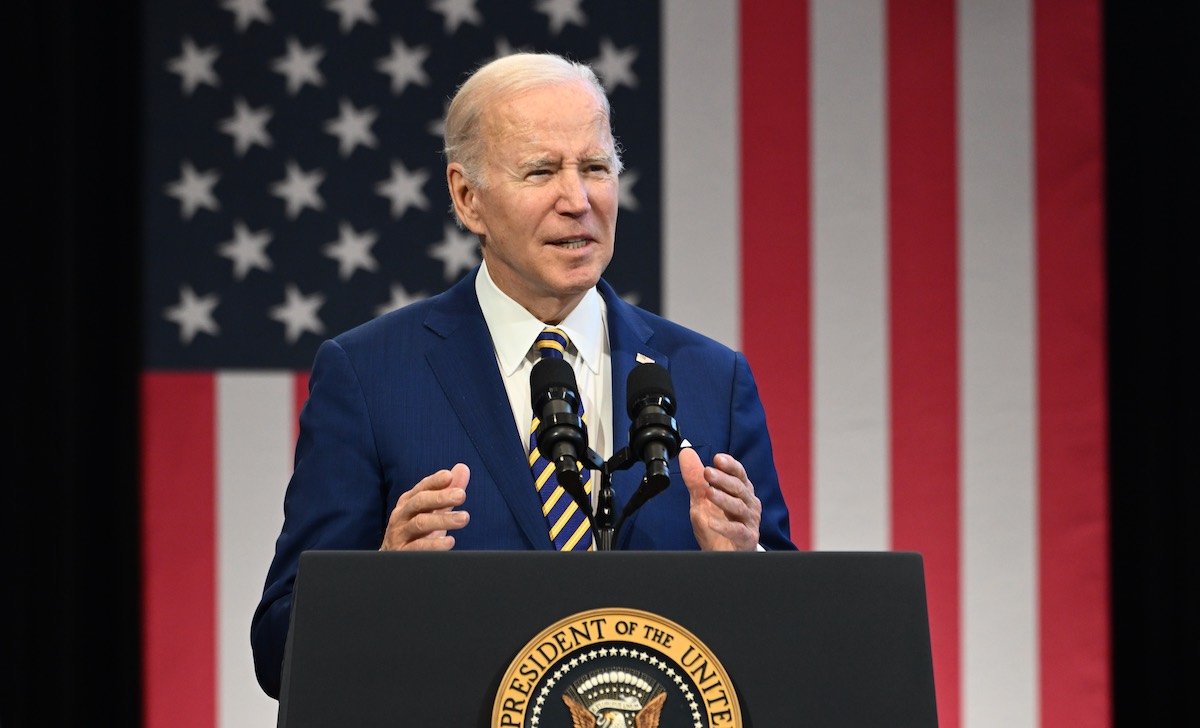On Thursday, President Biden spoke for the first time regarding a series of recent incidents involving the downing of unidentified objects detected in U.S. and Canadian airspace.
Speaking from the White House, Biden said the incidents followed recent enhancements to radar systems that allowed the U.S. military and the North American Aerospace Defense Command (NORAD) to scrutinize American airspace more closely and that the shootdowns had been “in accordance with established parameters in determining how to deal with unidentified aerial objects in U.S. airspace.”
The President said he had given orders to shoot the objects down because of the potential hazard they posed to aviation and because the U.S. “could not rule out the surveillance risk of sensitive facilities.”
“Our intelligence community is still assessing all three incidents,” Biden said. “They are reporting to me daily, and will continue their urgent efforts to do so, and I will communicate that to the Congress.”
Biden said U.S. intelligence agencies had not yet determined conclusively what the objects were and that recovery efforts to collect debris were still ongoing.
“Nothing right now suggests they were related to China’s spy balloon program,” Biden said, “or that they were surveillance vehicles from any other country.”
“These three objects were most likely balloons tied to private companies, recreation or research institutions studying weather, or conducting other scientific research,” Biden said.
Biden said that since taking office, he has taken the threat potential from unidentified aerial objects, or what the Pentagon characterizes as unidentified anomalous phenomena (UAP), very seriously and has directed the intelligence community to collect as much data on the phenomena as it can.
Biden added that the U.S. intelligence community is aware of a range of entities that include countries, U.S. companies, and scientific research organizations, all of which “operate objects at altitudes that are not nefarious” and often for purposes that “include legitimate scientific research.”
The President also remained unapologetic for ordering that the objects be shot down, actions which some critics characterized as an overreaction following criticism Biden received after a Chinese spy balloon was allowed to drift across the United States before being shot down off the South Carolina coast.
“Make no mistake, if any object presents a threat to the safety and security of the American people, I will take it down,” Biden said.
Biden also said on Thursday there was no indication that there has been a “sudden increase” in the appearance of unidentified objects in U.S. and Canadian airspace.
Biden said additional classified procedures the U.S. will put into effect for any similar future incidents involving unidentified aerial objects deemed to be a threat to U.S. airspace will be provided to Congress.
“They’ll remain classified,” Biden said, “so we don’t give our roadmap to our enemies to try to evade our defenses.”
Biden says his National Security Adviser Jake Sullivan will be tasked with leading a government-wide effort to ensure the U.S. “is positioned to deal safely and effectively with the objects in our airspace.” The effort, Biden said, will keep a tighter inventory of objects known to be operating in U.S. airspace, in addition to implementing better measures at detecting those that remain unknown.
The President also said there would be updates to rules and regulations related to the launch and operation of unmanned objects in U.S. airspace, and that “common global norms” would be established in an effort led by U.S. Secretary of State Antony Blinken that would address such issues, which currently remain largely unregulated.
“As the events of the previous days have shown, we will always act to protect the interest of the American people and the security of the American people,” Biden said.
Biden also said that recovery efforts to retrieve components that were on board the Chinese spy balloon shot down off the South Carolina coast earlier this month were largely successful and that several portions of the balloon’s payload had been recovered.
“We’re analyzing them as I speak,” Biden said, “and what we learn will strengthen our capabilities.” Biden said that the U.S. will continue to engage with China in the aftermath of the incident, working to maintain “open lines of communication” between Chinese and U.S. officials.
“I will remain in communication with President Xi,” Biden said, thanking the military and intelligence community for their efforts throughout the course of the recent incidents, which had left many American citizens and elected officials confused and frightened.
“I make no apologies for taking down that balloon,” Biden said as he concluded his remarks on Thursday.
In the days preceding Biden’s statements on Thursday, Senators received a classified briefing on Capitol Hill which appeared to leave many of them unsatisfied with the U.S. military and intelligence community response to the recent incidents.
“I think at a minimum our Director of National Intelligence should go in front of the American people and explain what we know and what we don’t know without divulging any classified information,” said Senator John Kennedy, R-Louisiana, speaking with reporters following Tuesday’s classified briefing.
Senator Richard Blumenthal, D-Connecticut, told reporters he had a “better understanding” of the incidents following Tuesday’s briefing, but that he felt “the American people deserve and need to know more.”
Blumenthal added that he was “not in any way afraid that we are under a threat of attack or physical harm to our homeland.”
Lawmakers in Washington were not the only ones who responded to the recent incidents with calls for greater transparency.
“The unprecedented military action this past week against unidentified objects in U.S. and Canadian airspace requires the Biden Administration to work transparently with the scientific community to share information and data that will allow academics to help address the problem of UAP identification,” read a statement issued on Thursday by the Scientific Coalition for UAP Studies (SCU), a data-driven organization comprised of scientists, academics, and research professionals advocating scientific studies of anomalous aerospace phenomena.
“Such open research will help the public more fully understand the nature, causes, and consequences of the many reports of anomalous objects in our skies,” the SCU’s statement read.
Robert Powell, an SCU Executive Board Member, says his organization draws a clear distinction between truly anomalous aerospace phenomena that some military personnel say they have encountered and the recent incidents involving suspected surveillance balloons and other unmanned objects.
“The Chinese surveillance airship is not unidentified aerial phenomena,” Powell told The Debrief in an email, noting the speed at which U.S. officials detected and identified the balloon and its suspected operators early last week.
“A Chinese airship is very quickly identified as such,” Powell said. “Its shape is clear, as well as its movement characteristics.”
According to an unclassified version of a 2022 ODNI report on UAP made publicly available in January, 171 incidents currently being evaluated by the DoD’s All-domain Anomaly Resolution Office (AARO) remain unresolved. “Some of these uncharacterized UAP appear to have demonstrated unusual flight characteristics or performance capabilities,” the report states, “and require further analysis.”
However, Powell told The Debrief the 2022 ODNI report did not provide enough data regarding “shape, velocity, method of detection, location, or any other information” on UAP and that the SCU encourages the DoD and the Biden Administration to be more transparent with instances that are not believed to be associated with foreign surveillance.
“I think AARO and ODNI need to explain why there is this level of difference in providing information,” Powell says.
Independent researcher and Metabunk founder Mick West told The Debrief that the recent incidents involving balloons show that the Pentagon is becoming better equipped at detecting objects and identifying them, although it could have done so much sooner.
“I think the revelations of the detection of prior balloon intrusions reflect technology finally getting a handle on a firehose of previously unusable data, but probably much later than it could have,” West told The Debrief.
“Balloons are not that important to ballistic missile defense and provide only weak radar returns,” West says. “So, according to Chris Mellon, they were previously filtered out with the rest of the noise. The raw data is still available and could be used to disambiguate pilot reports of UAP, where the radar shows they move like balloons.”
West said that past efforts by the Pentagon to collect information on incursions by what it characterized as unidentified aerial phenomena “seemingly failed to do this, as they did not identify any of the cases as small balloons,” which resulted in a veritable “black hole for UAP reports.”
“More recently,” West adds, “the analyses using historical radar data seem to have developed to use ‘patterns of life’ techniques, as mentioned by Kirkpatrick in the Dec 16, 2022, press briefing.”
“This type of analysis can be used to detect anomalies and would likely have been what found the historical balloon intrusions,” although West adds that it is “unfortunate it was not used earlier.”
Shortly before Biden issued his remarks on Thursday, The Debrief reached out to NORAD and the Department of Defense for additional comment on the recent incidents. Although responses were received to our queries, neither agency would provide any further details on the incidents or specific answers to our additional queries.
While the U.S. continues to close in on more effective methods of detecting and evaluating UAP reports, several questions remain about the ongoing suspected incursions into U.S. airspace.
“I imagine some of these are going to have explanations that are pretty simplistic,” said Senator Marco Rubio, D-Florida, following Tuesday’s classified briefing on Capitol Hill.
“Others are gonna be more complicated. I imagine some are frankly gonna be crafts that were launched by a company, an individual, or whatever.”
“And others may not be,” Rubio added, suggesting that some may be technologies developed “by nation states that have developed some rudimentary capability that can collect intelligence or test aerospace defenses of the United States.”
“That’s why we want this to be handled from a data and scientific perspective,” Rubio added, “but it begins by using this process that Congress created for them,” referring to the current efforts by AARO and its evaluation of the current batch of data collected by the intelligence community about unknown aerial threats.
“So far, it appears they’re not using that,” Rubio added.
Micah Hanks is the Editor-in-Chief and Co-Founder of The Debrief. He can be reached by email at micah@thedebrief.org. Follow his work at micahhanks.com and on Twitter: @MicahHanks.

